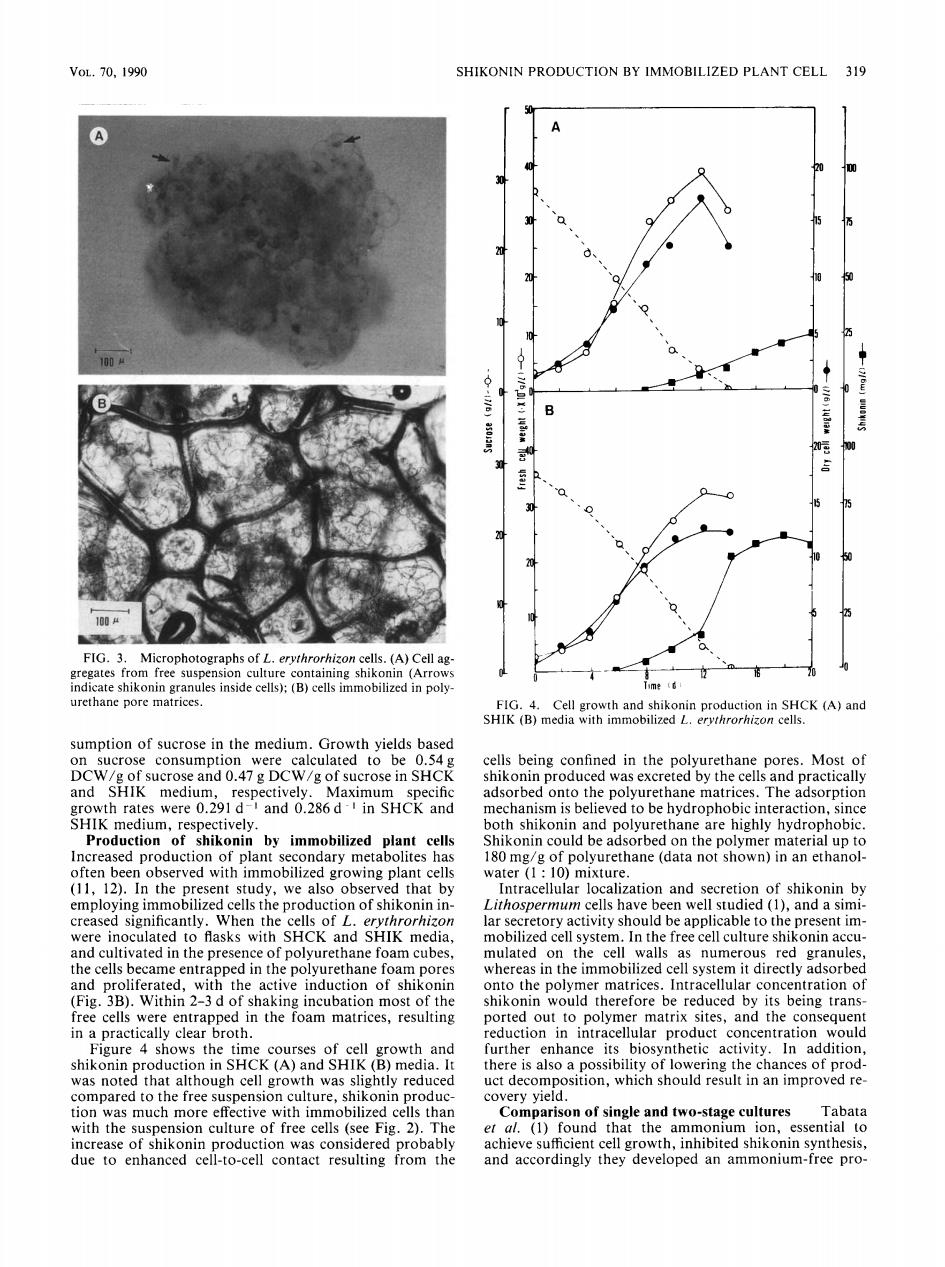正在加载图片...

VoL.70,1990 SHIKONIN PRODUCTION BY IMMOBILIZED PLANT CELL 319 A 100丛 白 B 20 1004 FIG.3.Microphotographs of L.erythrorhizon cells.(A)Cell ag- gregates from free suspension culture containing shikonin (Arrows indicate shikonin granules inside cells);(B)cells immobilized in poly- urethane pore matrices. FIG.4.Cell growth and shikonin production in SHCK (A)and SHIK (B)media with immobilized L.erythrorhizon cells. sumption of sucrose in the medium.Growth yields based on sucrose consumption were calculated to be 0.54 g cells being confined in the polyurethane pores.Most of DCW/g of sucrose and 0.47 g DCW/g of sucrose in SHCK shikonin produced was excreted by the cells and practically and SHIK medium,respectively.Maximum specific adsorbed onto the polyurethane matrices.The adsorption growth rates were 0.291 d-and 0.286 d in SHCK and mechanism is believed to be hydrophobic interaction,since SHIK medium,respectively. both shikonin and polyurethane are highly hydrophobic. Production of shikonin by immobilized plant cells Shikonin could be adsorbed on the polymer material up to Increased production of plant secondary metabolites has 180 mg/g of polyurethane (data not shown)in an ethanol- often been observed with immobilized growing plant cells water (1:10)mixture. (11,12).In the present study,we also observed that by Intracellular localization and secretion of shikonin by employing immobilized cells the production of shikonin in- Lithospermumn cells have been well studied (1),and a simi- creased significantly.When the cells of L.erythrorhizon lar secretory activity should be applicable to the present im- were inoculated to flasks with SHCK and SHIK media, mobilized cell system.In the free cell culture shikonin accu- and cultivated in the presence of polyurethane foam cubes, mulated on the cell walls as numerous red granules the cells became entrapped in the polyurethane foam pores whereas in the immobilized cell system it directly adsorbed and proliferated,with the active induction of shikonin onto the polymer matrices.Intracellular concentration of (Fig.3B).Within 2-3 d of shaking incubation most of the shikonin would therefore be reduced by its being trans free cells were entrapped in the foam matrices,resulting ported out to polymer matrix sites,and the consequent in a practically clear broth. reduction in intracellular product concentration would Figure 4 shows the time courses of cell growth and further enhance its biosynthetic activity.In addition, shikonin production in SHCK(A)and SHIK (B)media.It there is also a possibility of lowering the chances of prod- was noted that although cell growth was slightly reduced uct decomposition,which should result in an improved re- compared to the free suspension culture,shikonin produc- covery yield. tion was much more effective with immobilized cells than Comparison of single and two-stage cultures Tabata with the suspension culture of free cells (see Fig.2).The et al.(1)found that the ammonium ion,essential to increase of shikonin production was considered probably achieve sufficient cell growth,inhibited shikonin synthesis, due to enhanced cell-to-cell contact resulting from the and accordingly they developed an ammonium-free pro-VoL. 70, 1990 SHIKONIN PRODUCTION BY IMMOBILIZED PLANT CELL 319 FIG. 3. Microphotographs of L. erythrorhizon cells. (A) Cell aggregates from free suspension culture containing shikonin (Arrows indicate shikonin granules inside cells); (B) cells immobilized in polyurethane pore matrices. sumption of sucrose in the medium. Growth yields based on sucrose consumption were calculated to be 0.54g DCW/g of sucrose and 0.47 g DCW/g of sucrose in SHCK and SHIK medium, respectively. Maximum specific growth rates were 0.291 d ' and 0.286 d ~ in SHCK and SHIK medium, respectively. Production of shikonin by immobilized plant cells Increased production of plant secondary metabolites has often been observed with immobilized growing plant cells (11, 12). In the present study, we also observed that by employing immobilized cells the production of shikonin increased significantly. When the cells of L. erythrorhizon were inoculated to flasks with SHCK and SHIK media, and cultivated in the presence of polyurethane foam cubes, the cells became entrapped in the polyurethane foam pores and proliferated, with the active induction of shikonin (Fig. 3B). Within 2-3 d of shaking incubation most of the free cells were entrapped in the foam matrices, resulting in a practically clear broth. Figure 4 shows the time courses of cell growth and shikonin production in SHCK (A) and SHIK (B) media. It was noted that although cell growth was slightly reduced compared to the free suspension culture, shikonin production was much more effective with immobilized cells than with the suspension culture of free cells (see Fig. 2). The increase of shikonin production was considered probably due to enhanced cell-to-cell contact resulting from the A "~. "~, -. ~ i ~0 "" ,O 15 15 "'"" 10 ~l "o. I~me i d FIG. 4. Cell growth and shikonin production in SHCK (A) and SHIK (B) media with immobilized L. erythrorhizon cells. cells being confined in the polyurethane pores. Most of shikonin produced was excreted by the cells and practically adsorbed onto the polyurethane matrices. The adsorption mechanism is believed to be hydrophobic interaction, since both shikonin and polyurethane are highly hydrophobic. Shikonin could be adsorbed on the polymer material up to 180 mg/g of polyurethane (data not shown) in an ethanolwater (1 : 10) mixture. Intracellular localization and secretion of shikonin by Lithospermum cells have been well studied (1), and a similar secretory activity should be applicable to the present immobilized cell system. In the free cell culture shikonin accumulated on the cell walls as numerous red granules, whereas in the immobilized cell system it directly adsorbed onto the polymer matrices. Intracellular concentration of shikonin would therefore be reduced by its being transported out to polymer matrix sites, and the consequent reduction in intracellular product concentration would further enhance its biosynthetic activity. In addition, there is also a possibility of lowering the chances of product decomposition, which should result in an improved recovery yield. Comparison of single and two-stage cultures Tabata et al. (1) found that the ammonium ion, essential to achieve sufficient cell growth, inhibited shikonin synthesis, and accordingly they developed an ammonium-free pro-